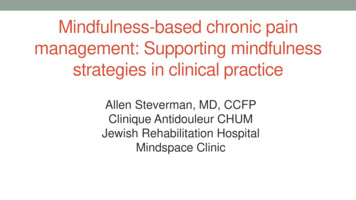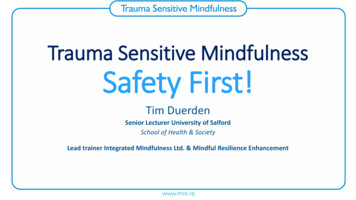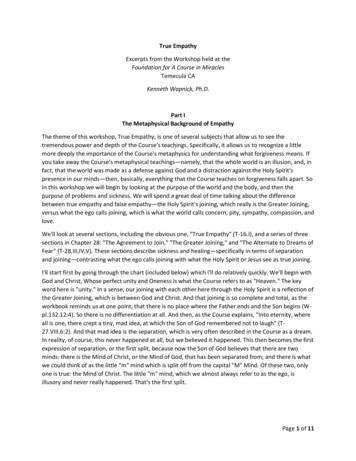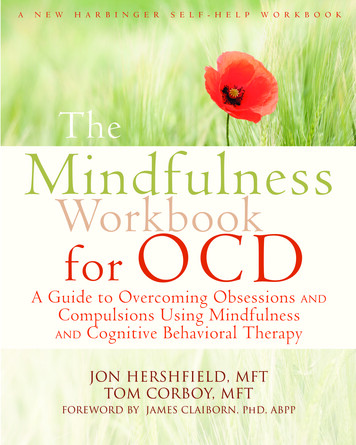
Transcription
IS MINDFULNESS JUST ANOTHER EGO DEPLETION EXERCISE?Melissa Londoño Connally, B.A.Thesis Prepared for the Degree ofMASTER OF SCIENCEUNIVERSITY OF NORTH TEXASMay 2014APPROVED:Amy R. Murrell., Major ProfessorAdriel Boals, Committee MemberRandall J. Cox, Committee MemberVicki Campbell, Chair of Department ofPsychologyMark Wardell, Dean of the ToulouseGraduate School
Connally, Melissa Londoño. Is Mindfulness Just Another Ego Depletion Exercise?Master of Science (Psychology), May 2014, 61 pp., 4 tables, references, 98 titles.Given increasing interest in the therapeutic benefits of mindfulness, limitations of itstreatment utility are frequently questioned. As such, the purpose of the study was to examine theeffects of mindfulness on a subsequent self-control task in a sample of college students. A totalof 67 participants were randomly assigned to one of three conditions: a control condition, anexperimental mindfulness-only condition or a comparison expectancy-plus-mindfulnesscondition to investigate the utility of mindfulness practice when motivated by an outcome ofincreased self-control. Results did not indicate a difference in persistence on a difficult taskbetween conditions, regardless of the manipulation. Conceptual and experimental limitations ofcurrent study’s findings, as well as future directions, are discussed.
Copyright 2014byMelissa Londoño Connallyii
ACKNOWLEDGEMENTSFirst and foremost, I thank my major professor, Dr. Amy Murrell, for making personalsacrifices in order to support me. I have been privileged to be a recipient of your teachings andwitness to your valued living. You have influenced me to think big and ask important questions.I also appreciate my thesis committee members, Dr. Adriel Boals and Dr. Randall Cox,for your time, encouragement, and faith. You have played an immensely influential role in myprofessional development and it was an honor to work with you both on this project.Finally, I am fortunate to have the support and collaboration of my fellow graduatestudents in the North Texas Contextual Psychology Group. My family, for their unconditionalsupport despite geographical distance. Above all, my husband, Kenneth, who is patient beyondmeasure and my dearest friend and supporter.iii
TABLE OF CONTENTSPageACKNOWLEDGEMENTS . iiiChapters1. INTRODUCTION .1Self-controlEgo DepletionMindfulnessACTThe Present Study2. METHOD .18ParticipantsMeasuresProcedure3. RESULTS .24Data Preparation and Preliminary AnalysesHypothesis Testing4. DISCUSSION .29Hypothesis 1Hypothesis 2Hypothesis 3Hypothesis 4ImplicationsLimitationsFuture DirectionsAPPENDIX .45REFERENCES .48iv
CHAPTER 1INTRODUCTIONThe desire for increased self-control and willpower is dominant in America. As anindividualistic culture, value is placed on ability, self-achievement, and production (Kitayama,Conway, Pietromonaco, Park, & Plaut, 2010). The American Psychological Association’s annualStress in America survey found that 27% of Americans believe lack of willpower to be thelargest barrier to behavioral change (2011). The need for sustained vigilance and effective outputleads individuals to seek out simple and effective means to continue performing at their best. Agrowing trend is the consumption of large quantities of energy drinks; the average Americanconsumes 1.2 gallons per year as demonstrated in a 2010 survey, compared to 0.5 gallons fiveyears prior (Zmuda, 2011). In fact, Molden et al. (2012) found that even rinsing one’s mouthwith an energy drink has motivational implications for increased self-control.Lasting solutions to increase self-achievement are also sought. For example, a largevolume of self-help books have been written in response to the perception that it is important tocontrol emotions and engage in extended outcome-oriented behavior. A search for books byAmerican writers using key words “self-help” and “control” on WorldCat.com brought up 6,502results. A common topic among these titles is one of diet and exercise. In the generalcommunity, the use of dietary supplements to expedite goal weights and the use of maladaptiveeating behaviors in an effort to obtain command of weight each have a long history with selfcontrol (Conner, Kirk, Cade, & Barrett, 2001; Rezek, 1991).The increased use of prescription medications to treat attention deficit hyperactivitydisorder (ADHD) symptoms, an area of much dispute, may help illustrate the need for a solutionto staying on task and handling distractions (McCabe, Cranford, Teter, Rabiner, & Boyd, 2012).1
Moreover, the off-prescription use of these same chemicals by college students is on the rise(McCabe et al., 2012). Productivity was the reason most commonly endorsed for use of nonprescribed ADHD medication (Novak, Kroutil, Williams, & van Brunt; 2007). ADHD is relatedto deficits in tasks related to executive functioning, including response inhibition, attention, andworking memory (Rubia, 2010; Rubia et al., 2001; Seidman, 2006; Weijer-Bergsma, Formsma,Bruin, & Bӧgels, 2012). In order to address these deficits, mindfulness training was found toreduce attention and behavioral problems, and improve executive functioning in adolescents(Weijer-Bergsma et al., 2012); and adults (Zylowska et al., 2008).Mindfulness’ increased Western popularity has led to its introduction into empiricallysupported therapies; however, this focus has never been in the context of self-control researchand it has not been with the ambition of increasing one’s self-regulatory abilities. Mindfulnesstechniques have been proposed as a method for increasing self-control once an individual hasbeen depleted of their self-control resources. This preliminary evidence, however, should befurther explored to identify the limitations (Friese, Messner, & Schaffner, 2012). Competingresearch suggests that mindfulness may function as a self-regulatory process, requiring aneffortful awareness of both internal and external stimuli (Bishop et al., 2004). This may suggestmindfulness can exhaust as well as replenish self-control resources. If mindfulness is expected toincrease self-control, would engaging in mindfulness practices always serve as beneficial? It isalso unclear whether mindfulness would still “work” if it were used solely for the motivation ofincreasing self-control. This specific question has not been answered before, as mindfulness istypically described as an experience free of expectations (Hayes, Strosahl, & Wilson, 1999). Thecurrent study proposes that mindfulness, with the expectation of increased self-control, mayinstead function to decrease self-control.2
The concern at hand is if whether using mindfulness practice to counter self-control isalways useful, or if suppressing natural responses to avoid discomfort is problematic.Suppression has been found to be cognitively costly and yield more of the distress one wished toavoid (John & Gross, 2004). Cognitive effort, in attempting to suppress a thought, showsparadoxical effects, rendering those thoughts more persistent (Wegner, Schneider, Carter, &White, 1987). Avoidant coping (strategic attempts to escape stressful experiences) is acomponent of experiential avoidance (Kashdan, Barrios, Forsyth, & Steger, 2006). Experientialavoidance is the engagement in avoidant behaviors to resist or control private events (e.g.,thoughts, feelings, bodily sensations; Hayes, Wilson, Gifford, Follette, & Strosahl, 1996).Oftentimes controlling private experiences can be useful (e.g., attempting to hide anxiety duringpresentations); however, Kashdan and colleagues explain the process becomes problematic whencontrolling is applied rigidly, inflexibly, and excessively – especially when it gets in the way ofliving one’s life in a valued way (2006).Self-controlFrom a cognitive tradition, the role of the self is to be in control of overt behavior andprivate processes, like thinking and feeling; therefore, the self must expend itself to exert control(Baumeister, Muraven, & Tice, 2000). Baumeister (1998; 2002) conceptualized the self intothree fundamental experiences: (a) basic awareness of self-relevant information (e.g., selfknowledge, self-esteem), (b) interpersonal processes (e.g., self-presentation), and (c) executivefunction (cognitive processes that regulate, control, and manage self-relevant actions, of both thecovert and overt types).Executive function captures externally-oriented acts of volition and internally-orientedprocesses of self-regulation. More specifically, self-control is the term used to describe the3
conscious and deliberate efforts to regulate behaviors, such as in the presence of impulses andtemptations (Baumeister, 2002). Unsuccessful efforts in self-control are related to a broad rangeof behaviors. In fact, self-control failure has been linked to obesity, drug abuse, violent crime,inability to manage finances, eating disorders, unplanned pregnancy, sexually transmitteddiseases, and some chronic diseases (e.g., cancer and heart disease; Baumeister, Heatherton,Tice, 1994; Hagger, Wood, Stiff, & Chatzisarantis, 2010; Muraven & Baumeister, 2000; Wills &Stoolmiller, 2002). Thus, self-control’s expansive involvement in human behavior makes for animportant area of study.Tangney, Baumeister, and Boone (2004) developed a scale to measure individualdifferences in self-control in the areas of thoughts, emotions, performance regulation, and habitbreaking. More specifically, the items assess abilities to plan ahead, organize, consideralternatives, and manage time appropriately as well as abilities to delay impulses, gain inertiaand exhibit willpower. Individuals with higher self-control scores were found to have highergrade-point averages in college, report fewer impulse control problems (including binge eatingand alcohol abuse), and have healthier and more stable interpersonal relationships. Additionally,the study found people high in self-control reported less psychopathology and fewer mentalhealth problems (e.g., higher self-acceptance or self-esteem) and had fewer emotional problems(e.g., less shame, less anger, and better management of anger). Adolescents who are higher inself-control are less likely to participate in delinquent misbehaviors (e.g., fighting, vandalism,petty theft) and have better relationships with their parents (Engles, Finkenauer, den ExterBlokland, & Baumeister, 2000). Although it has been hypothesized that there might be acurvilinear relationship with high levels of self-control being problematic, several studies havefound no evidence to support this concern (Tangney et al., 2004). Zabelina, Robinson, and4
Anicha (2007) reported that self-control has been found to promote consistency in traits;however, this consistency is at the expense of affect and spontaneity. More research in this areais needed to indicate if these deficits may be problematic and to determine the contextualrelevance of these findings.Ego DepletionSelf-control’s relationship to positive outcomes has led to efforts in understanding whysome individuals have better or poorer self-control. Ego depletion refers to the temporary state ofreduced self-control capacity, or reduced willingness to engage in a volitional action followingan initial effortful act of will (Baumeister, Bratslavsky, Muraven, & Tice, 1998). The term wascoined to pay tribute to Sigmund Freud, who contributed one of the first energy models for theself, or ego (Baumeister, Bratslavsky, Muraven, & Tice, 1998). Importantly, rather than referringto self-control as an entity or the presence of something, the focus has been shifted to a deficit.The implication of conceptualizing self-control in this way communicates the want or need formore of it.Ego depletion measurement. The measurement of ego depletion utilizes tasks that requirean individual to exert self-control. Ego depletion is typically measured using the dual-taskparadigm, which requires that all participants complete two performance tasks which mayinterfere with one another. Experimental-condition participants complete two consecutiveunrelated self-control tasks, while control condition participants complete only the secondarytask that necessitates self-control (Baumeister et al., 1998, Finkel et al., 2006; Muraven, Tice, &Baumeister, 1998). A meta-analysis by Hagger, Wood, Stiff, and Chatzisarantis (2010) reportedthe most frequently used tasks for initial depletion are video-watching affect regulation(watching an emotionally evocative video while suppressing emotions), video-watching attention5
control (watching a dull, uneventful film waiting for “something” to occur), crossing out letters,the modified Stroop (1935; which requires participants to say the color of the ink color words areprinted in while suppressing the urge to just read the words), and Wegner et al.’s (1987) whitebear thought suppression task (in which participants are asked to not think about a white bear).Repeatedly used dependent tasks are the handgrip physical stamina task, solvable anagram task(solving anagrams that get increasingly difficult in a short period of time), food taste test(continuously resisting the urge to eat an enticing food for a duration of time), math or mentalarithmetic, and the modified Stroop (Hagger et al., 2010). The use of ego depletion tasks invarious areas of functioning (e.g., physical stamina and affect control), demonstrategeneralizability to the commonly occurring demands of self-control.Ego depletion theories and related empirical support. Self-control and ego depletionhave been conceptualized in various ways. The most studied theory is that of Baumeister andcolleagues. According to Muraven and Baumeister’s (2000) self-control strength model, selfregulatory failure occurs because self-control is a limited resource - comparable to a tiredmuscle. When an individual exerts self-control in the performance of one task, the exertioncauses performance decrements in subsequent, likely unrelated, tasks also requiring self-control.Like the necessary recovery period for muscles, rest and recuperation help to renew self-controlresources (Baumeister & Heatherton, 1996, Muraven & Baumeister, 2000, Tyler & Burns, 2008).Muraven et al. (1998) administered the white bear thought suppression task followed bythe unsolvable anagram task, which is a dependent measure of self-control as measured bypersistence, to 51 undergraduate students. Individuals in the white bear suppression conditiongave up faster on the anagrams, indicating the regulation of thoughts depleted the self-controlresource. This process held true with regulation of emotional reactions. Muraven, Tice, and6
Baumeister (1998) had individuals regulate their emotional reactions to a distressing video clipthen asked the participants to perform a behavioral measure of self-control (handgrip task ofphysical stamina). They found the individuals who had controlled their reactions also had shorterhandgrip duration times.Following this model, regular training, which entails engaging in repeated tasks requiringself-control, improves self-control capacity and lessens the ego-depletion effect (Hagger, Wood,Stiff, & Chatzisarantis, 2010). For example, regular exercise in self-regulation activities (e.g.,regulation of posture, eating habits, and emotions) everyday for two weeks, led to improvementin self-regulatory abilities (Muraven, Baumeister, & Tice, 1999).Additionally, ego depletion may be impacted by the expectations of future outcomes.Studies by Muraven, Shmueli, and Burkley (2006) found after an initial depleting task,participants who were informed about the subsequent task would require self-control, performedworse on said self-control task, demonstrating motivation to conserve self-control resourcesoccurs with the anticipation of possible self-control tasks. Alternatively, people may not be ableor willing to draw from those resources (Baumeister & Vohs, 2007; Muraven & Baumeister,2000). For instance, participants may have had a certain degree of exertion they were motivatedto put forth for an experiment.A recent study by Kidd, Palmeri, and Aslin (2012) revisited Mischel’s (1974) classicmarshmallow task, introducing environmental reliability into the decision-making mix. In theclassic marshmallow task, a marshmallow is presented to child with the instructions they can eatthe marshmallow now, or wait for the researcher to come back and eat two marshmallows. In theKidd, Palmeri, Aslin study, children who were given reason to believe their environment wasreliable made rational decisions to wait significantly longer to consume the marshmallow as7
compared to the children in the unreliable condition. This study emphasizes the role of context,including learning histories, to understand other contributing factors when engaging in selfcontrol.Competing theories posit that self-regulatory failures can be attributed to skill, fatigue,motivation, self-efficacy, affect, or be conceptualized as an artifact of experimenter demand(Hagger, Wood, Stiff, & Chatzisarantis, 2010). Two studies have shown acts of self-controlresulted in reductions in glucose levels, which also predict poor self-control in future behavioraltasks, proving a physiological explanation for depletion (Gailliot & Baumeister, 2007; Gailliot etal., 2007). However, a small number of studies using similar methods have not found significantego-depletion effects (e.g., Stillman, Tice, Fincham, & Lambert, 2009; Wright et al., 2007;Wright, Stewart, & Barnett, 2008), indicating the process is not sufficiently understood.Counteracting ego depletion. Given the notion that self-control is integral in variousdomains of living, methods of counteracting ego depletion have been proposed and empiricallytested. In one of the previously mentioned studies that found a physiological effect of egodepletion (Gailliot & Baumeister, 2007), researchers discovered replenishing individuals with asufficient amount of glucose aided in increasing the self-control source. Gailliot andBaumeister’s (2007) study found depleted individuals quit sooner on the prolonged effortful taskafter being asked to think about death, yet a glucose shake worked to replenish their self-controlresources.Another study introduced implementation interventions to counteract the effects of egodepletion (Webb & Sheeran, 2003). Implementation interventions are a method of instructing theindividual to follow a procedure in order to ensure success in the task by passing control toenvironmental cues. Results of one experiment indicated that the implementation intervention8
(instructing the individual to only focus on the second letter of the word) during the Stroop taskresulted in longer duration efforts on a subsequent unsolvable puzzles task compared to thosewho did not use the intervention. A different experiment, by the same researchers, usedindividuals who were depleted on an initial self-control task and found the same implementationintervention improved performance on the later administered Stroop task (Webb & Sheeran,2003).Another way to counteract the occurrence of ego depletion is to include self awareness inexperimental paradigms (Alberts, Martijn, & de Vries; 2011). It was theorized that participantswho receive self-awareness primes would not demonstrate decreases in their performance onsecondary tasks of self-control. Therefore, Alberts et al. (2011) had participants complete a selfawareness manipulation consisting of sentences related to the self using the scrambled sentencetask (SST; Srull & Wyer, 1979). The study found participants who were exposed to the selfawareness manipulation performed significantly better (i.e., persisted longer) on the dependentmeasure of self-control (handgrip task).It is important to note the SST may be limited to the degree to which it explains the levelof self-awareness in which the individual is engaged; therefore, what impact self-awareness mayactually have on self-control may be inaccurate. One explanation is that self-awareness preventsindividuals from becoming overly focused on the present, and instead aids in directing theirbehavior toward future outcomes (Kuhl, 1982; Vohs & Schmeichel, 2003).In contrast, mindfulness, a process of self-awareness and contact with the presentmoment, was investigated to determine its relationship to ego depletion. Friese, Messner, andSchaffner (2012) found a brief period of mindfulness counteracted the effects of self-controlexertion. Specifically, participants were distributed into one of three experimental conditions (no9
emotion suppression, emotion suppression, and emotional suppression plus meditation). Theparticipants were shown videos selected to evoke reactions of disgust, and the suppressionconditions was asked to suppress emotional reactions. The emotional suppression plusmeditation condition was asked to engage in meditation for a duration of five minutes, while theother conditions completed a mundane task. Lastly, all conditions were asked to complete a taskof attention and concentration to measure self-control. Results demonstrated those in the emotionsuppression conditions showed decrements in self-control performance on the self-control task.Individuals who meditated performed as well as individuals who had not exerted self-control(emotion suppression) in the first task. However, the participants in the study were approachedon the second day of a 3-day introductory meditation seminar. This allowed the individuals to beexposed and trained on mindfulness practices for at minimum a full day. Therefore, they likelyalready adjusted to the sensations of engaging in mindfulness. The participants also sought outmindfulness by enrolling in the workshop and likely welcomed and were prepared for theexperience.MindfulnessMindfulness goes beyond awareness in regards to allowing an individual to experiencethe present moment non-judgmentally and openly, including one’s sensations, thoughts, bodilystates, consciousness, and other factors in the environment (Kabat-Zinn, 2003). Mindfulness isdifferent than meditation, in that meditation is the practice of increasing the skill of mindfulness,in order to attend to every momentary experience (Kabat-Zinn, 2005, Shapiro, Carlson, Astin, &Freeman, 2006). A method of increasing mindfulness skills involves focusing attention on thebreath, and as thoughts and feelings arise, demonstrating acceptance of them and gentle10
redirection to the breath. With practice, these skills can be applied throughout the day to bringawareness to the present, using the breath as an anchor (Bishop et al., 2004).Mindfulness is a type of mental training to decrease mental vulnerability that may lead toemotional distress or enable psychopathology (Bishop et al., 2004). The mental training isbelieved to mediate observed effects on mood and behavior (Kabat-Zinn, 2005). Rather thanfurther ruminating on thoughts, a thought is acknowledged, and then attention is guided back tothe breath (Bishop et al., 2004).However, mindfulness is not a relaxation technique. In fact, people are likely notmindful, because for some, their moment to moment experience is painful (Rosch, 2007).Mindfulness involves a direct experience of events in the mind and body and with the externalworld. When individuals have experience in meditation, the observation of experiences and theability to view them in an accepting, compassionate way are positively correlated. Without themeditation practice, these processes are negatively correlated—observing is associated withjudging (Baer et al., 2006).Mindfulness’ recent attention in the areas of psychotherapy and empirical psychology hasalso raised an interest in better understanding the process. Eleanor Rosch (2007) emphasizes theimportance of investigating the types of experiences a person may have in response tomindfulness instructions, as use of mindfulness techniques vary in practice. Therefore there isimportance in identifying the mechanisms of action (Baer, 2003). More research is needed todetermine if there is a true distinction between the psychological effects of mindfulness andrelaxation, and if mindfulness offers something unique to current cognitive-behavioralinterventions.11
Mindfulness is being included in more therapies, and it is important to examine theimplications of its use. For example, mindfulness based stress reduction (MBSR), dialecticalbehavior therapy (DBT), mindfulness based cognitive therapy (MBCT), and acceptance andcommitment therapy (ACT), all involve training in mindfulness in an effort to improve mentalhealth. These “third wave behavioral therapies” tend to use mindfulness techniques andexperiential change strategies to change an individual’s relationship to psychological eventsrather than directly change the content. All of these treatments include acceptance of bodysensations (e.g., pain, discomfort), thoughts, and feelings without attempting to change, escape,or avoid them (Baer, 2003). ACT, however, is the first therapy to use values and commitment toaction as targets of behavioral activation (Rosch, 2007).ACTThe current study is conceptualized from an ACT perspective. ACT (Hayes, Strosahl, &Wilson, 1999) is an approach to treatment that integrates a mindful component to connect withthe present moment. Contact with the present moment is one of six core processes of the ACTmodel, which also includes acceptance, cognitive defusion, self-as-context, valuing, andcommitted action. Mindfulness changes the context in which thoughts or feelings occur, ratherthan attempting to change an individual’s thought content (Hayes & Plumb, 2007; Teasdale,Moore, & Hayhurst, 2002). ACT emphasizes the role of language as a method of avoidingcontact with private experiences (e.g., bodily sensations, thoughts, emotions, memories; Hayes etal., 1999). This process is termed experiential avoidance – the act of controlling or changing theform, frequency, or situational sensitivity of internal experiences, even when efforts to controlthese private experiences cause harm (Hayes, et al., 1996). These efforts are typicallymaladaptive strategies and are significantly related to general and specific presentations of12
psychological symptoms and problem behaviors (Bishop et al., 2004; Hayes et al., 2004; Hayes,Luoma, Bond, Masuda, & Lillis, 2006; Kashdan, Barrios, Forsyth, & Steger, 2006; Schmalz &Murrell, 2010).Mindfulness is incorporated to help individuals “defuse from,” or become less attachedto, the literal meaning of their thoughts. An individual, for example, might become aware of theirbodily sensations and thoughts, and subsequently demonstrate a non-judgmental acceptance ofexperiences rather than engage in control strategies in attempts to remove or alter them.Mindfulness includes the deliberate decision to let go of one’s agenda so that thoughts, feelings,and sensations may be experienced freely (Hayes, Strosahl, & Wilson, 1999).However, mindfulness requires extensive training and practice. It is not natural, typicalhuman behavior to nonjudgmentally accept one’s internal experiences, a phenomenon that maybe difficult to capture in research and clinical settings (Roemer & Orsillo, 2003). Baer, Smith,and Allen (2004) found that simply observing one’s experiences does not indicate acceptance.Observing is positively correlated with dissociation, thought suppression, and psychologicalsymptomatology (Baer, Smith, Hopkins, Krietemeyer, & Toney, 2006). This suggests thatunless approaching experiences in an accepting, non-judgmental manner, simply observing maylead to the initially maladaptive behaviors of resisting and avoiding unwanted sensations.Bishop et al. (2004) propose mindfulness is in itself an act of self-regulation of attention,involving sustained attention, attention switching, and the restriction of further processing. Therelationship between mindfulness and self-control has been previously explored. In a study byBlack, Semple, Pokhrel, and Grenard (2011), self-control schedule scores and planful behaviordimension scores correlated with a measure of mindful attention and awareness. Thisrelationship between self-control, mindfulness, and planning may emerge because the benefits of13
mindfulness can be thought of as increased self-regulation or self-control. Bowlin and Baer(2012) help make a distinction between these two constructs; they found mindfulness accountsfor a significant amount of variance in psychological wellbeing, over and above self-control, andmindfulness moderates the relationship between self-control and psychological symptoms.Role of instructor. A teacher or facilitator is typically involved in the aforementionedtherapy systems using mindfulness training as a component. Individuals are not left to their ownaccord; instead, they are given specific sets of instructions (Rosch, 2007). Instructors serve tolead research participants or clients through mindfulness trainings and allow them time to attendto their breathing, to become aware of thoughts or bodily sensations, and to remind them to staywith the experience.Role of letting go. All of the mentioned therapy systems inc
mindfulness can exhaust as well as replenish self-control resources. If mindfulness is expected to increase self-control, would engaging in mindfulness practices always serve as beneficial? It is also unclear whether mindfulness would still "work" if it were used solely for the motivation of increasing self-control.










